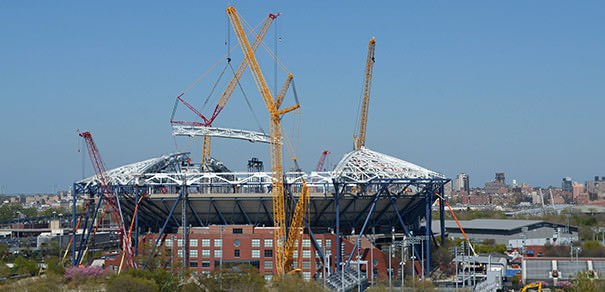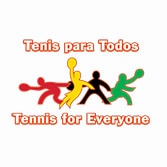Get ready for the boom.
The term “game changer” almost does a disservice to what American tennis, it’s fans and players alike, will experience at both the pro and recreational levels by the end of 2016.
Let’s look into the crystal ball and start with the…
PRO TOUR
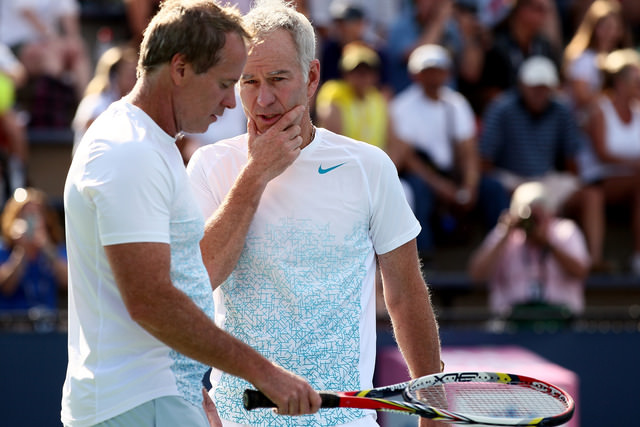
If it wasn’t enough at one point simultaneously serving as USTA general manager of professional development, U.S. Davis Cup coach, and ESPN tennis commentator, you also had your brother John yelling at you. American tennis is just now sprouting the seeds planted by Patrick McEnroe during his USTA professional development tenure.
Right now we’re seeing the fruits of the changes Patrick McEnroe and his staff planted over the last six years in his reign as general manager for player development at the USTA.
From pushing the 10 and Under Tennis mandate for getting kids brought up in the game with right-sized equipment, to getting more high-level junior tournaments played on clay, to embracing college tennis as a valid avenue to the pros, to funding personal coaches and regional training centers, and on and on, McEnroe’s changes are now making a difference in the slow-moving world of professional development.
“It’s very difficult to create top-level players,” McEnroe said upon retiring from the position. “I think I have a newfound respect for what my parents did to create two players, one who was really good and another who was pretty good.”
This year saw the first-ever all-American boys’ French Open final, with a slew of U.S. youngsters such as Stefan Kozlov, Jared Donaldson and Frances Tiafoe ready for pro breakthroughs, to name just a few. The women’s side is more than healthy with 12 or so players ranked in the Top 100, with more in the wings.
New USTA Professional Development General Manager Martin Blackman says he is ready to further build on McEnroe’s foundation of collaboration to launch future generations of men’s and women’s pros, from wherever they originate.
“I see my role as being a team leader, not a public figure,” Blackman said in a recent USTA Twitter chat. “I will manage professional development to ensure that we work in a systematic way to collaborate with the private sector to develop Top 100 players.”
A year and a half from now, by the end of 2016, the U.S. pro tennis landscape will be vastly changed.
THE US OPEN
Serena Williams can seemingly stay No. 1 into her 40s if she wished, but for those waiting for a breakthrough on the men’s side, 2016 could be your year — coinciding with the debut of the new closed roof on Arthur Ashe Stadium.
Earlier this month they laid the final beam on the underlying superstructure, capping 5,000 tons of steel and part of a $500 million expenditure that will also see a new Grandstand court, an expanded and friendlier grounds area, and more.
So the US Open will finally be getting a new roof. Why all the fuss? Because now we can have men’s and women’s finals despite the annual rain and hurricane/tropical remnants in September in New York, and it’s part of what allows the USTA to make $825 million, 11-year deals with ESPN for broadcast coverage, such as was announced last year. It costs the USTA millions every time there is a rain-out at the US Open, and lest you think the non-profit is flush with cash, they are borrowing money to build the two giant projects, the US Open roof and the new training headquarters in Orlando, at the same time.
All this effort and attention to detail and fan experiences keep the US Open THE highest-attended, highest-grossing annual sporting event in the world. This allows the USTA national body to distribute more than $100 million annually to the 17 USTA Sections across the country for community tennis funding and grants, not including other grants from USTA national, or grants generated by the sections or their individual foundations.
THE “NEW HOME OF AMERICAN TENNIS”
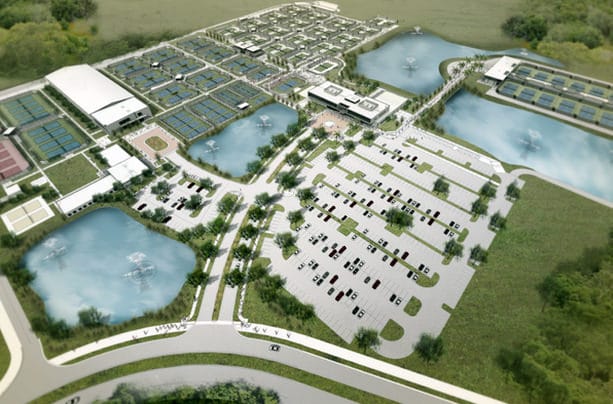
Artist rendering of the USTA National Campus in Lake Nona, slated to be finished in the fourth quarter of 2016
If you’re a tennis fan you’ve probably heard of a cow pasture in the Lake Nona area of Orlando that is currently being turned into the biggest tennis facility ever in existence in the U.S.
The 100-court, $60 million USTA National Campus will be the U.S.’s new training center for professional tennis, but it will serve an equally-important distinction as an incubator for youth tennis, adult recreational tennis and cutting-edge sports science.
“We know the Florida Section has been working really hard on trying to grow the game here in the state of Florida,” said USTA President Katrina Adams. “By having this facility and the Florida Section’s involvement, we’re going to get a lot of youngsters that will be even more excited to come to this wonderful facility.”
Among the 100 courts will be 36-foot and 60-foot courts for youth development, courts with cameras where players participating in USTA League championships or other events can immediately download video of their matches, a college showcase area that will be the home of the University of Central Florida team, and much more. And open to the public.
Other game changers making an impact by 2016-17:
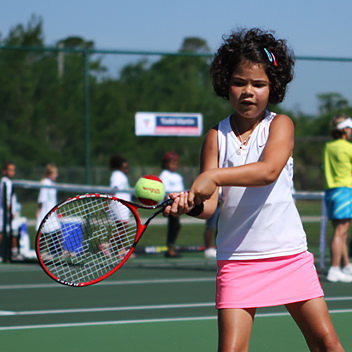
Next month the USTA Florida Section will debut a new tournament structure for players age 11 and younger that will revolutionize the way junior tournament players are developed.
Around the country we’re already seeing some amazing 14-and-under tournament players who have been brought along strictly with the USTA 10 and Under Tennis right-sized equipment for kids, and their ball control, utilization of spin, touch, ability to change speeds, etc., is incredible. For the longest time tennis in the U.S. has been it’s own worst enemy in terms of insisting on developing children with adult equipment.
The USTA national body is currently looking at adopting a similar tournament youth pathway nation-wide.
“You look at baseball: kids don’t start on a world-class baseball field; peewee football is on a smaller field,” said USTA National President Katrina Adams. “Tennis was kind of behind the ball there, and now we are right in the forefront of changing and making those developments so that we are a kid-sized sport now.”
TENIS PARA TODOS (Tennis for All)
USTA Florida introduced Tenis para Todos years back to get more Hispanic families in Florida in the game.
The USTA national body is now taking over the Florida Tenis para Todos website to supercharge Hispanic outreach across the U.S., making the tennis-playing demographic more representative of the overall U.S. population.
Florida now has a lot more families and youngsters participating in tennis, and combined with innovations from other USTA sections and the coming national push, we could be in for a Hispanic tennis boom.
Vamos!
MASTERS TENNIS
USTA Florida rolled out “Masters Tennis” four years ago in an effort to get more seniors back into the game on smaller 60-foot courts using the easier-to-control “orange ball.” As the out-of-control Pickleball explosion has shown, older players are more than willing to play on smaller courts with modified equipment, and most seniors who play say it’s even more fun, and still good exercise, with the 60-foot court.
If you think about it, you probably don’t see a lot of teams of 55+ players attempting full-court basketball. Just like half-court hoops, 60-foot tennis with orange balls maintains all the fun of the game, without as much court coverage or risk of injury.
This is another program the USTA national body is considering on a national scale by 2016.
“We have a tendency to really start to lose some of our senior [players] over time just because of physical ailments, and we are trying to create opportunities for them to stay in the game much longer,” Adams says. “We’re encouraging those older players to use those [60-foot] courts with the lower compression balls.”
WHAT IT ALL MEANS
The tail end of 2016 is roughly a year and a half away. In internet years that’s a long, long time. You’ll be able to stream any professional tennis match from any tournament by then, and probably most college matches, and your computer will probably be able to make you a full breakfast.
In terms of U.S. pro and community tennis we’ll have a roof on Arthur Ashe Stadium and a state-of-the-art 100-court training center and “Home of American Tennis” in Orlando. The end of 2016 will also be post-Rio Olympics, rumored to be a potential mass retirement date for 30+ age players like Roger Federer, Serena and Venus Williams, Tommy Haas and the Bryan brothers, to name only a few. Ready for the post-Serena era? I’m not — unless a Madison Keys or Sloane Stephens is ready to step into that void.

From left: 2014 Wimbledon boys’ champ Noah Rubin and runner-up Stefan Kozlov of Florida after the all-American final
Pro tennis is cyclical, and that cycle for the U.S. is currently on the rise, and will be shooting up by the end of 2016. Last year’s American Wimbledon champion Noah Rubin and this year’s American French Open champion Tommy Paul have both just turned pro.
On the rec. side, approximately 890,000 players participated in USTA League tennis last year, a record number that is on track to be surpassed in 2015.
The combination of the debut of the USTA National Campus in Orlando, the US Open retractable roof and other additions at Flushing Meadows, and increased tennis programming to meet the needs to recreational players should make the latter part of 2016 the beginning of another golden era in American tennis.
Have I just drank too much of the Kool-Aid, or will we see U.S. tennis at the pro and recreational levels get super-charged by the end of 2016 and entering 2017?
What do you think?

